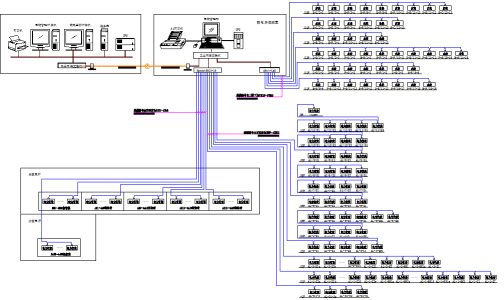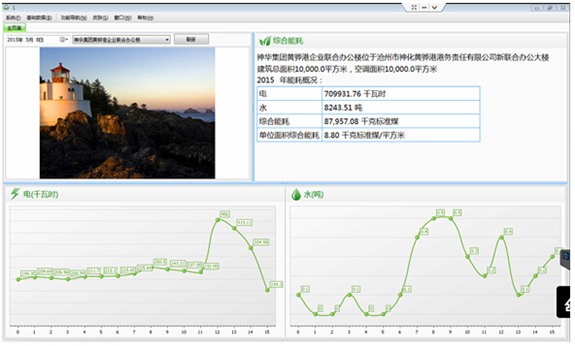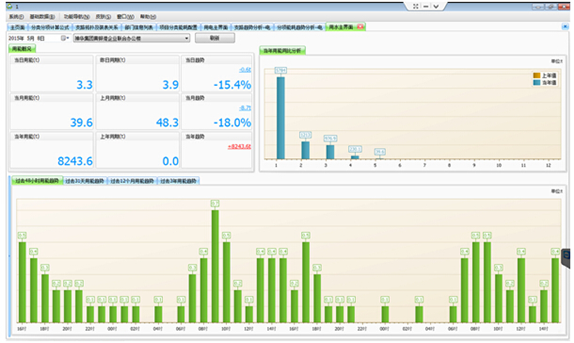Application of ACREL-5000 Energy Consumption in the Joint Office Building of Huanghua Port, Shenhua Group
Anke Rui Qiu Hong Jiangsu Ankerui Electric Appliance Manufacturing Co., Ltd. Jiangyin, Jiangsu 214405 Abstract: This article describes the integrated building of the joint office building of Huanghua Port of Shenhua Group. It uses smart power meters to collect various electrical parameters and switch signals at the distribution site. The system adopts on-site local networking method. After networking, it communicates via the field bus and transmits it to the background. Through the Acrel-5000 building energy consumption monitoring system, power distribution circuit and on-site gas meters, flow meters, etc. are realized in real time. monitor. Keywords: large-scale public buildings; energy consumption monitoring system; ACREL-5000; 1 Introduction The total area of ​​large-scale public buildings is less than 4% of the total area of ​​urban buildings, but the total energy consumption accounts for 22% of the total electricity consumption in the country's cities and towns. The annual consumption of large-scale public buildings per unit area reaches 70 to 300KWh, which is 10 for ordinary residential buildings. ~ 20 times. Public buildings are important for energy conservation and energy conservation. To do a good job in energy conservation in public buildings is of great significance in promoting and stimulating energy conservation in the entire society, realizing energy conservation and emission reduction targets, and implementing the major strategy of “turning modes and adjusting structuresâ€. At present, China is already the world’s second largest energy producer and consumer. According to statistics, China’s building energy consumption accounts for about 28% of the country’s total energy consumption. In China’s newly built 2 billion square meters of buildings, 99% of which are It is a high-energy-consuming building; only 4% of the existing buildings have adopted energy-saving measures. Large-scale public buildings not only have high energy density, but also have very serious energy waste. They have huge space for energy conservation. The promotion of building energy-saving has become imperative, and energy conservation and consumption reduction are the priorities. In order to conscientiously implement the spirit of the "Notice of the Provincial Office of the People's Government of Hebei Province to forward the Provincial Development and Reform Commission, the Provincial Office of Housing and Urban-Rural Development, <Implementation Opinions on the Implementation of the Green Building Action to Create an Energy-Saving Province," (Gao Zheng Office [2013] No. 6), Effectively promote the green building action to create energy-saving provinces The following requirements were made: 2013 was the year of creation, 20% of the creation task was completed; 2014 was the year of creation work, and 40% of the creation task was completed; 2015 was the creation work In the closing year, 40% of the creation task is completed, that is, the task of creating the building energy saving province is basically completed, and the work is systematically summarized to facilitate the further improvement of the building energy saving and the level of green building development. Shenhua Group Huanghua Port Corporate Office Building belongs to a large-scale public building and is one of the goals of creating a building energy-saving province. 2 Design basis GB-T 15587-2008 "Energy Management Guidelines for Industrial Enterprises" "Evaluating the rational use of electricity technology guidelines GB" "General Rules for the Preparation of Energy-saving Planning for Enterprises" "General Principles of Energy Auditing for Enterprises - GB" GBT23331-2009 Energy Management System Requirements GB-50052-2009 "Power Supply and Distribution System Design Specifications" â—† Energy consumption measurement device national and industry standards DL/T 645-1997 Multifunctional Energy Meter Communication Protocol DL/T 645-2007 multi-function energy meter communication protocol CJ/T 188-2004 household meter data transmission technical conditions GB/T 19582-2008 Industrial Automation Network Specification Based on Modbus Protocol 3 Project Overview Shenhua Huanghua Port is currently the second largest coal port in China. It was formally started construction on December 25, 1997 and put into operation at the end of 2001. Shenhua Huanghua Port Co., Ltd. is a project legal person in Huanghua Port and is jointly funded by Shenhua Group and Hebei Construction Investment Company. Among them, Shenhua accounts for 70% and Hebei Construction Investment accounts for 30%. Since the opening of the port, Huanghua Port has fully demonstrated its advantages in integration of mines, roads, ports, electricity, oil, and transportation of Shenhua Group. It has grown by 10 million tons in five years and accumulated more than 700 million tons of coal. In order to ensure energy supply in the coastal areas of East China and South China, it has made due contributions to the economic development in the central and western regions of China. The on-site equipment in the project is located in the office building B1F-11F. It is necessary to include the meter and water meter in the monitoring scope, supervise the situation of various energy consumption, grasp the energy consumption at any time, and raise awareness of energy conservation. 4 System Architecture Acrel-5000 building energy consumption analysis management system is based on workstation host, communication equipment, and measurement and control unit. It provides a basic platform for real-time data acquisition, switch status monitoring and remote management and control of large-scale public buildings. It can The detection and control equipment constitutes an arbitrarily complex monitoring system. The system mainly adopts a hierarchical distributed computer network structure, as shown in the system structure diagram: Shenhua Group Huanghua Port Enterprise Joint Office Building Project Energy Consumption System Station Control Management and Network Communication Layer. The field equipment is distributed in the office building B1F-11F. There are a total of 80 multi-function network power meters, 75 rail-mounted energy meters and 49 ultrasonic meters. System structure 6 system software module â—† Comprehensive energy consumption main interface Reflect the energy consumption of each category in the year of the building and convert it into the equivalent energy consumption of standard coal, and calculate the energy consumption per unit area; Although there are many types of energy consumption in a building, the main electricity, water, gas, and renewable energy sources that can be measured by meters are displayed. The energy consumption curve of the four types of energy consumption is displayed on the interface at the bottom of the day; click each The upper area of ​​the classification energy consumption can be jumped to the energy consumption analysis main interface of the classification energy consumption; The building can be switched through the drop-down box. The building picture can be replaced according to the project requirements; â—† Classified energy consumption main interface Reflect the energy consumption (for example, electricity) of a certain category and the same period of yesterday, the same period of previous month, the energy consumption and comparison of the same period of the previous month, the same period of the previous month, the current year and the same period of the previous year, the growth percentage and the added value; Reflect energy consumption trends of the past 48 hours, the past 31 days, the past 12 months, and the past 3 years of a certain classification energy consumption; The monthly energy pie chart reflecting the energy consumption of a certain item; Reflecting the energy consumption of a certain category in the same year, the monthly energy use analysis graph; â—† Classification energy consumption branch energy statistics report It can flexibly select the branch road and count the daily, monthly, weekly, seasonal and annual energy use of the branch energy during a certain period of time; Through the powerful function of the pivot table, the user can perform a variety of data statistics and sort the data in combination; Statistical data can be displayed by various charts such as histograms, dotted charts, stacked charts, and pie charts; Statistics can be exported to Excel; â—† Classified energy consumption branch non-working daily energy Statistics on working days and non-working days for each branch, and non-working days can be set flexibly through the system Statistics can be exported to Excel; â—† Category energy consumption branch year-on-year analysis Statistics on the monthly energy use for each branch and the energy consumption for the same period last year; â—† Classified energy consumption branch energy use Query the meter readings for any two branches of each branch and calculate the difference; Time accuracy to minutes; â—† Trend analysis of energy consumption by time for classified energy consumption branches The energy parameters (such as voltage, current, power, power factor, etc.) of any branch can be queried during a certain period of time. The specific queryable parameters are related to the installed instruments and system configurations. The data is displayed in the form of a chart or a table. The chart can be zoomed in, zoomed out, or moved by mouse operation; the data can be sorted (maximum, minimum); Data can be exported to Excel; â—† Configuration Options According to the relevant technical specifications, the basic information of the building is configured, such as: building function, building area, air-conditioning area, building address, etc., in which the building area and other information will be used to analyze energy consumption per unit area; Configure the basic information such as the type, model, and manufacturer of the instrument used in the project, and add the monitoring parameter information that can be provided by this type of instrument. The configuration affects the energy consumption statistics, time-separated energy statistics, and parameter query functions. All metering instruments used in the configuration project, save metering instrument address, transformation ratio, corresponding collector, code, monitoring circuit name and other information; The information related to metering, proportioning, and calculation methods involved in configuring itemized energy consumption statistics can be flexibly configured according to the situation of the project. The configuration information here will affect the energy consumption analysis of each classification. ; Configure the measuring instruments, computing methods, proportions, and department energy plans for each department's energy use. After completing this configuration, the department's energy consumption analysis module will be enabled. Configure the meter, calculation method, and proportion of an energy use area in the building. After completing this configuration, the regional energy consumption analysis module will be enabled. 7 Outlook According to the analysis of the energy consumption operation effect of the joint office building of Huanghua Port of Shenhua Group, a typical energy consumption analysis model was established and analyzed. a. Establish a building energy consumption measurement system, focus on the building energy consumption, find the energy consumption shady, and make more energy-saving changes. At the same time, strengthen the energy-saving transformation results through management measures such as measurement fees and performance assessment. b. Select energy-efficient equipment. c. Even the best energy-saving equipment can't control waste and can't exert energy-saving effect. By increasing automation energy-saving equipment, formulating equipment operation strategies, reducing human intervention, and centralizing management and control, energy-saving equipment is achieving energy conservation. d. Quantify the results of energy-saving transformation through the same-ring analysis data provided by the energy consumption monitoring system to maximize the energy-saving effect. 8 Conclusion The total area of ​​large-scale public buildings is less than 4% of the total area of ​​urban buildings, but the total energy consumption accounts for 22% of the total electricity consumption in the country's cities and towns. The annual consumption of large-scale public buildings per unit area reaches 70 to 300KWh, which is 10 for ordinary residential buildings. ~ 20 times. Public buildings are important for energy conservation and energy conservation. The energy-saving work of the joint office building of Huanghua Port in the Shenhua Group is of great significance to promoting and stimulating energy conservation and achieving energy conservation and emission reduction targets. references: Ministry of Housing and Urban-Rural Development Technical Requirements [2008] No. 114
PP water tank can be used in acid and alkali resistant equipment, environmental protection equipment, waste water, waste gas emission equipment, washing tower, dust-free room, semiconductor plant and related industrial equipment, is also the preferred material for making plastic water tanks
PP water tank has the characteristics of light weight, uniform thickness, smooth surface, good heat resistance, high mechanical strength, excellent chemical stability and electrical insulation, non-toxic, and so on Custom Tanks,Chemical Custom Tanks,Stainless Custom Tanks Shenzhen Xicheng Plastic Co., Ltd. , http://www.china-xicheng.com




